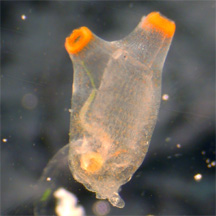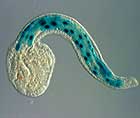tags: cancer, liposarcoma, trabectedin, Ecteinascidia turbinata, sea squirt
 A toxin derived from a humble sea squirt, Ecteinascidia turbinata (pictured, right), shows great promise as an anti-cancer drug. This toxin, known as trabectedin (ecteinascidinin-743), shrinks and even completely removes cancerous tumors in more than half of the patients treated with it, according to a new study. The patients treated with this drug suffered from a specific type of liposarcoma cancer, which is associated with chromosomal mutations. Liposarcomas are a rare but malignant tumor that grow in the fat cells in deep soft tissue, such as inside the thigh or within the abdominal cavity.
A toxin derived from a humble sea squirt, Ecteinascidia turbinata (pictured, right), shows great promise as an anti-cancer drug. This toxin, known as trabectedin (ecteinascidinin-743), shrinks and even completely removes cancerous tumors in more than half of the patients treated with it, according to a new study. The patients treated with this drug suffered from a specific type of liposarcoma cancer, which is associated with chromosomal mutations. Liposarcomas are a rare but malignant tumor that grow in the fat cells in deep soft tissue, such as inside the thigh or within the abdominal cavity.
Dr Federica Grosso, from the Sarcoma Unit of the Instituto Nazionale Tumori in Milan, Italy, and her colleagues from sarcoma centers in Boston, London, Lyon and Paris, conducted this study. Out of 51 patients with myxoid liposarcomas that were treated only with trabectedin, they found that two had their tumors disappear completely (complete response) while another 24 experienced at least a 30% shrinkage of their tumor (partial response), representing an overall response rate of 51%.
Further, of the 26 patients who responded to the drug, 23 were subjected to a radiological review of their tumors. This review showed that 17 of these 23 experienced reduced tumor density prior to shrinkage or disappearance of their tumors.
The researchers also discovered that 88 percent of the patients survived at least six months and the average time that passed before the tumors began to regrow was 14 months.
"If the results of this analysis are reproduced in ongoing prospective studies, myxoid sarcoma would represent a uniquely sensitive subgroup to trabectedin treatment in the heterogeneous family of soft-tissue sarcoma," wrote the authors in their paper.
It is not yet known why this particular toxin works on this class of tumors, but this aspect is being investigated by the researchers.
Surgery is the current treatment for soft-tissue sarcoma, but it is not especially effective. Even after surgery, approximately half of all patients are found to develop secondary tumors (metastases) elsewhere in their bodies before they die. Some drugs, such as anthracyclines and ifosfamide, have shown response rates of only 20-40%, so new, more effective drugs are obviously needed.
"A much larger trial that compares two groups of patients -- one treated with the drug and one not -- will now be key to proving whether the humble sea squirt really can offer hope to people with cancer," observed Emma Knight, science information manager at Cancer Research UK, who was not part of this research.
 Sea squirts are a remarkable group of animals. Even though the adults are sessile (permanently fixed to a surface) and have soft, squishy bodies, they really are vertebrates without backbones. Because the free-swimming sea squirt larvae, known as tadpoles (pictured, right), develop a primitive spinal cord, these animals are grouped together with fish, birds and people rather than worms and other "squishy" invertebrates. Sea squirts share about 80 percent of their genes with humans and other vertebrates and thus, they are important research organisms that are contributing to our understanding of how vertebrates evolved. They produce powerful toxins as a defense against predators.
Sea squirts are a remarkable group of animals. Even though the adults are sessile (permanently fixed to a surface) and have soft, squishy bodies, they really are vertebrates without backbones. Because the free-swimming sea squirt larvae, known as tadpoles (pictured, right), develop a primitive spinal cord, these animals are grouped together with fish, birds and people rather than worms and other "squishy" invertebrates. Sea squirts share about 80 percent of their genes with humans and other vertebrates and thus, they are important research organisms that are contributing to our understanding of how vertebrates evolved. They produce powerful toxins as a defense against predators.
This study was published in the July issue of The Lancet Oncology.
Sources
Berkeley News Sea squirt genome sequenced

Fantastic.
Yes, yet another to protect diversity. As with cone snails.
I have to ask - how do we know that sea squirts are humble? Have they had profiles made, or is it just the lack of autobiographies entitled "How I Cured Cancer and Made a Killing" that gives it away?
Enquiring minds want to know!
Bob
Are these the same sea squirts that are creating such a nuisance in fisheries and marinas? I don't suppose "derived from" means they extract any chemicals from actual sea squirt bodies - nowadays, most everything's synthesized in a sterile setting. Still, it'd be ironic if colonies of a destructive invasive species were turned into the next marine "cash crop" and harvested as a source of life-saving drugs.